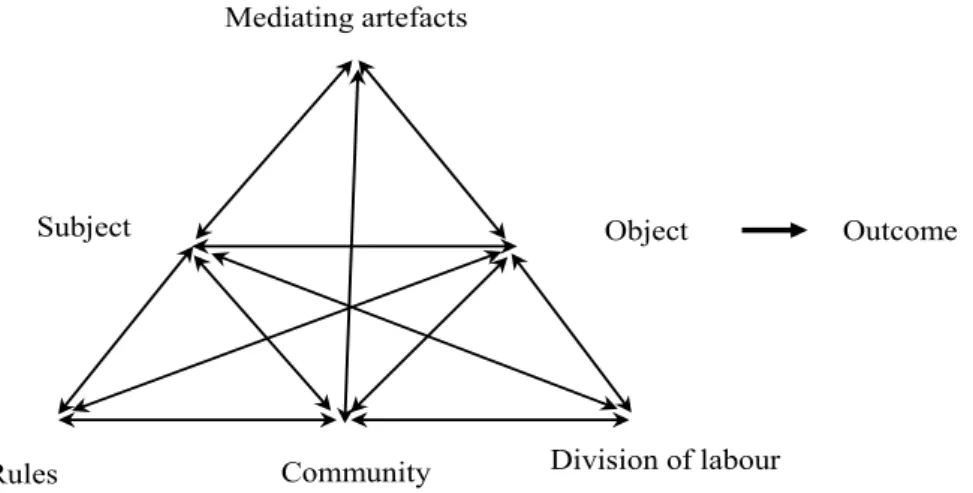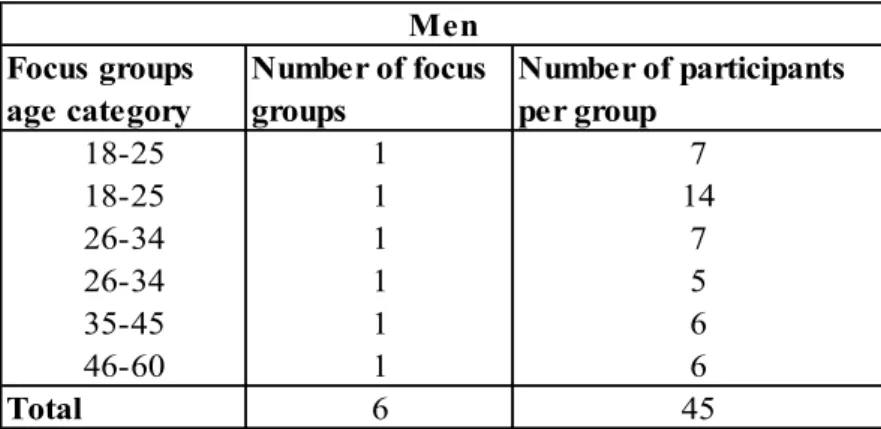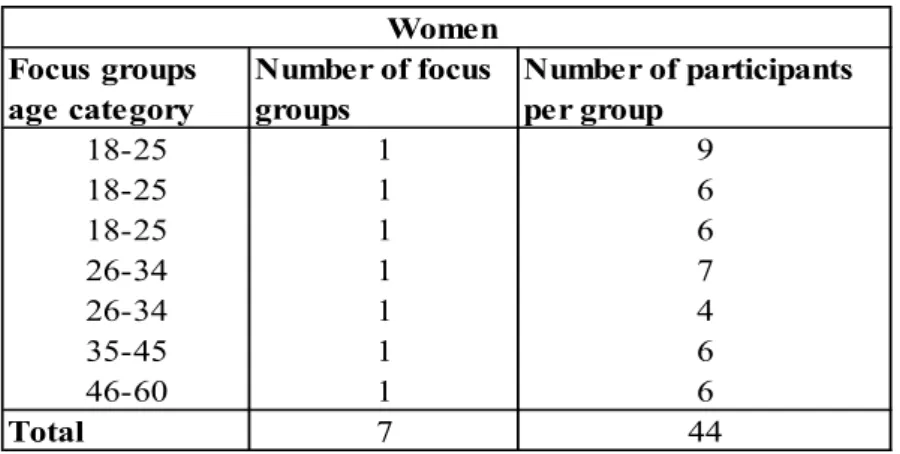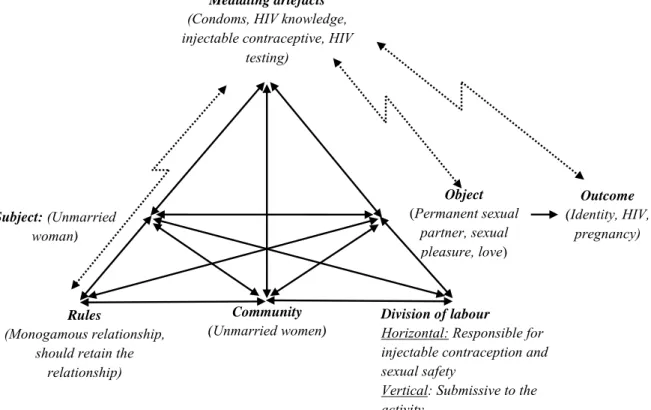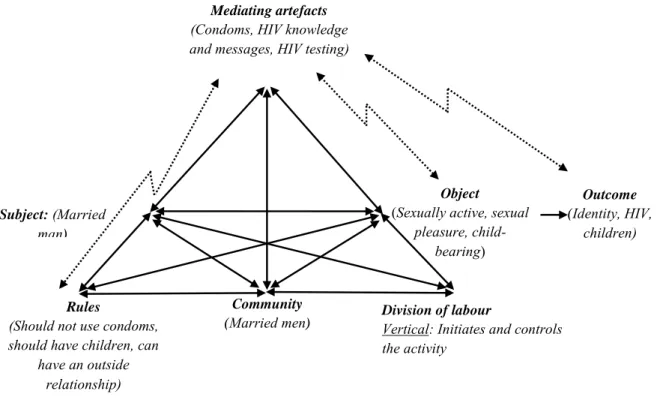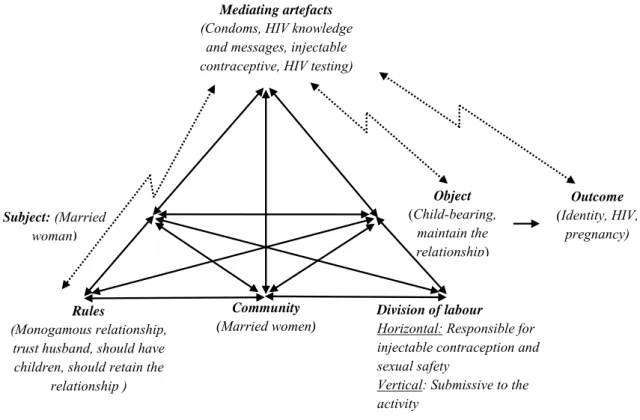He also explored how these tensions and dilemmas are related to the contradictions in the system of sexual activity and the state of contradiction in the system of activity. This lack of crisis in the activity system of men helps to understand the lack of change in sexual behavior.
INTRODUCTION
Introduction
Understanding the complexity of sexual activity and the complex social contexts of HIV and AIDS therefore requires an analysis of the activity. Van der Riet (2009) argues that this model provides an important advance in the understanding of the relationship between the context and the individual compared to that which is dominant in the field of HIV and AIDS.
The structure of the dissertation
A critical component of activity system analysis involves understanding, first, the components of the system, and especially the relationships between these components. Thus, analyzing activities in relation to the activity system helps to understand the ways in which behavior change does or does not occur.
LITERATURE REVIEW
Introduction
Socio-cultural factors
- Masculinity and femininity
- Gender, HIV and inequality
- Poverty
- Condom use in marriage
- Construction of trust and love
- Peer pressure
- Perception of risk
- Attitudes towards condom use
- The use of alcohol
This limited and unequal sexual power is significantly associated with inconsistent condom use (Pettifor et al., 2004). Many women who are economically dependent on their partners find it difficult to dictate condom use (Jewkes et al., 2003).
Theoretical framework
- Activity theory
- Contradictions, tensions and dilemmas
The secondary oppositions are between the components of an activity system (Engeström, 1999), for example the tension between the object and the result of sexual activity. Contradictions are important for understanding how an activity system works (Van der Riet, 2009).

Rationale and aims for the study
- Rationale
- Aims of the study
- Research questions
The study sought to understand the lack of change in sexual behavior in response to HIV and AIDS using the framework of activity theory (Engeström, 1987). Understanding the relative position of contradictions in the activity system helped to conceptualize HIV and AIDS interventions in similar contexts.
METHODOLOGY
- Introduction
- Research design
- Sample
- Research context
- Recruitment
- Sample characteristics for the larger project
- Interviews
- Focus groups
- Data processing
- Characteristics of the sample for this study
- Data analysis
- Thematic analysis
- Engeström’s model of the activity system
- Research quality
- Credibility
- Confirmability
- Dependability
- Transferability
- Ethical considerations
- Beneficence
- Non-maleficence
- Justice
- Dissemination of the study findings and data storage
- Summation
Before data collection of the larger project began, the research team prepared an interview guide. Demographics of interview participants used in this study are presented in the tables below.
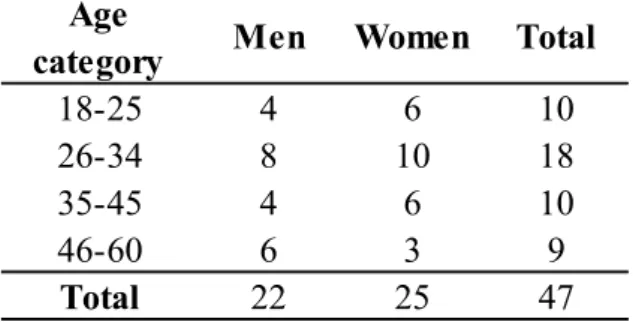
RESULTS
Introduction
Response to HIV and AIDS
- HIV and AIDS knowledge
- Misconceptions about HIV and AIDS
- Attitudes to condom use
Another example is found in the extract below, from an interview with a married woman (35-45 years). An example of this comes from a focus group of men in the age group 26-34 years.
Dominant sexual activity dynamics
- Low acceptance of condom use in marriage
- Extramarital sex
- Multiple sexual partners
- Alcohol and casual sex
- Inter-generational sex
- Male control of sex
- Fear of being ‘left alone’
- Unprotected sex demonstrates love and commitment
Another example is found in the extract below, from a focus group of women aged 46-60. An example of this is in the extract below, from a focus group of women aged 45-60. Another example is in the extract below from an interview of a married woman aged 35-45.
Another example can be found in the following excerpt from an interview with a married woman aged between 35 and 45. We found an illustration of this in the following extract from the target group of men aged 26 to 34. An illustration of this can be found in the following excerpt from the target group of women aged 26 to 34.
Another example can be found in the following excerpt, from an interview with a married woman between the ages of 26 and 34. An illustration of this can be found in the following excerpt from a focus group of young women between the ages of 18 and 24. Another example can be found in the excerpt below, from a focus group of women between the ages of 26 and 34.
Risk reducing behaviours adopted by population under study
- Condom use until trust is gained
- HIV testing
The following excerpt from an unmarried male participant aged 26-34 is another example of condoms being abandoned due to length of relationship. An illustration can be found in the extract below, from an interview with an unmarried woman aged 26-34. In the following excerpt from an interview with an unmarried man aged 26-34, the participant explains that HIV testing is another way to practice safe sex if you don't want to use a condom.
An example of this is shown in the excerpt below from an interview with an unmarried man between the ages of 26 and 34; he indicated that he and his partner got tested because they were tired of using condoms. In the following excerpt from an interview with a young man between the ages of 18 and 25, he reveals that he has tested but uses condoms “all the time” (line 77) because they have not been there. Another example of this was found in the following excerpt from an interview with an unmarried man between the ages of 26 and 34.
This is found in the following excerpt from an interview with an unmarried woman between the ages of 18-25. Another example is found in the extract below, from an interview with an unmarried woman between the ages of 35-45 years. An example comes from the following extract taken from an unmarried woman in the age group 26-34 years.
Data analysis using Engeström’s model of the activity system
- The sexual activity system of an unmarried man
- The sexual activity system of an unmarried woman
- The sexual activity system of a married man
- The sexual activity system of a married woman
- Tertiary contradictions
An analysis of the relationship between the subject and the object of the activity system revealed identity as the result of sexual activity. An examination of the data suggested the presence of tensions in the sexual activity system of an unmarried man. The analysis suggested the emergence of tensions in the activity system of the sexual activity of the unmarried woman.
This tension is a manifestation of the basic secondary contradiction between the object of the activity (having a permanent partner) and the mediating tool of the condom. The analysis of the relationship between the subject and the object of the activity system highlighted identity as an important part of the outcome of sexual activity. This tension creates a secondary contradiction between the object of activity, the birth of a child, and.
An analysis of the relationship between the subject and the object of the activity system highlighted identity (in relation to having children) as an important outcome of sexual activity. From the data analysis, the following tensions were observed in the sexual activity system of a married woman. This tension is a manifestation of a secondary contradiction between the object of the activity, childbirth, and the mediating tool of the condom.
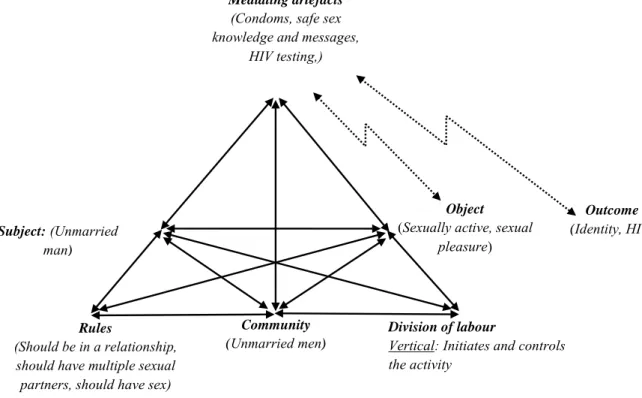
Summation
In both married and unmarried people there was a significant difference in power between a man and a woman. This was evident in cases where married women felt that it would be difficult for them to request the use of a condom or to negotiate condom use with their partner (as seen in extracts 53 and 55 above). Participants expressed helplessness in initiating condom use with their husbands because the husband controls how sex happens.
However, with unmarried couples, many women tried to initiate condom use although few succeeded (as seen in extracts 57, 58 and 59 above). Thus, the contradictions within the sexual activity systems of married people are at an early stage of maturity and are relatively stable compared to the sexual activity systems of unmarried people.
DISCUSSION
- Introduction
- Response to HIV and AIDS and condom use
- Dominant sexual behaviours in Ematyholweni
- Demonstrating reputation and virility
- Management of risk
- Fear of loss of partner
- Showing love and faithfulness
- Risk-reducing sexual behaviour in Ematyholweni
- Trust
- HIV testing
- Potential for change in the activity system of sexual activity
This was reflected in this study through the use of the isXhosa term isishumane (cobbler), a derogatory and shameful name for a man who has no sexual partners or has only one sexual partner (Van der Riet, 2009). They focused on satisfying their partner's sexual needs in order to maintain them, despite their awareness of the risk of HIV. The main contradictions arise within the outcomes of the sexual activity systems: identity (reputation) and risk of HIV.
The mediating artifact of the HIV risk conceptual system appears to be weak in their sexual activity systems. The main contradictions arise within the outcomes of the activity: identity (reputation) and risk of HIV. The mediating artifact of the HIV risk conceptual system appears stronger in their activity system.
The women's response was that they prioritized maintaining the relationship rather than reacting to their fear of the risk of HIV infection. Engeström (1996) argues that change can be facilitated by identifying tensions and contradictions within the activity system. The analysis of sexual activity systems in relation to tensions and contradictions showed resistance to changes in the system.
CONCLUSION
- Introduction
- Conclusions from the study
- Limitations and strengths of this study
- Credibility
- Dependability
- Confirmability
- Transferability
- Strengths of the study
- Recommendations
- Programmes
- Future research
- Conclusion
Reliability refers to the consistency of the data when another researcher replicates this study (Polit & Beck, 2004). Participants may have constructed their responses in relation to the researcher's gender or age. This may mean that the results of this study cannot be replicated due to the dynamics of the data collection.
Confirmability refers to the ability to maintain objectivity in data analysis (Polit & Beck, 2004). In this sense, the possibility of bias in the interpretation of the results is recognized. This study brought to the fore the nature of tensions and contradictions in the sexual activity systems of participants in a rural setting in the Eastern Cape.
This study is one of the few studies that used an activity theory framework in the field of HIV and AIDS. An application of the activity theory framework helped understand the relative state of contradictions in sexual activity. Factors influencing behavior change to prevent the spread of HIV/AIDS among students in Githunguri Division, Githunguri District, Kiambu County, Kenya.
Ethical clearance letter 1 for broader study
Ethical clearance letter 2 for broader study
Ethical Clearance for this study
Do you think it is important to worry about safe sex in your type of relationship. Do you think it is important to practice safe sex in your type of relationship. Do you know anyone in Ematyholweni who is HIV positive. Please do NOT tell me their names).
What do you know about antiretroviral therapy (ARVs)? What is it, what does it look like, how does it work?). What do you think about a woman carrying a condom with her? What do you think about a man carrying a condom with him? Do you think people in long-term relationships are concerned about the risks of sex.
Do you have any questions about the research process or what we discussed.
Transcription conventions
Extract codes
